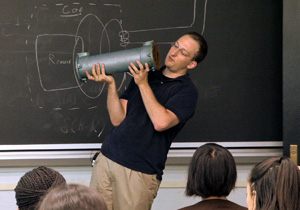In this section, Dr. Short shares some of his approaches for making this nuclear design class more tangible for his students.
I would say that no matter how theoretical and abstract the course, you can always put up a tangible physical to anything you're teaching. Here are some examples of how I made the subject matter more tangible for my students.
Using Reactor Parts as Pointers

Dr. Short holding up a fouled heat exchanger in Lecture 2. (Image courtesy of MIT OpenCourseWare.)
I'm not a big fan of laser pointers, and my students hadn't necessary touched any part of a reactor in their entire lives, so we're graduating all these Bachelors' in nuclear engineering without having touched pieces of a reactor.
So each day, I used a different piece of a reactor as a pointer. One day, I used a zirconium fuel rod. The next day I used a steam generator tube, and so on, and passed them around at the end of the class. I'd say, "Oh, by the way, today's pointer is a zirconium fuel rod. Pick it up. Notice how much lighter it is than steel. Try bending it. Notice how strong it is."
And just putting a tangible spin on something as abstract as designing a reactor on paper really helped students grasp it, get excited about it, and absorb the information.
Involving Students in Hands-On Experiences
Hands-on demos are key too. When we were talking about metallurgy, students were looking at things like quenched and tempered and annealed steel, which are different heat treatments you can do to increase strength or increase hardness at the cost of other things.
You can talk about it and teach it, the theory in its entirety on paper, or you can do what we did – go down to the blacksmith's forge, heat up some metal, and tell the students, “Alright, break it in half.” And then heat it and quench it in water and say, “Alright, break it in half,” and then it snaps. And then heat it slowly and say, “Break it in half,” and the strongest student can’t even make it budge. That’s the tangible analogue and the intuitive learning that students need to get no matter how theoretical the course.
Teaching Material Science with an Analogy: Cheese
One of my favorite moments – and I’m guessing it was also one of the students' favorite moments – was the cheese-tasting class that I taught. For the students that decided to stick it out until the day before Thanksgiving – which was, by the way, a school day – I taught a course on cheese tasting and linked every cheese that we tasted to a phenomenon that happens in materials science and metallurgy. Not all of these students had been required to take a materials science course, but they needed to understand the behavior of reactors in order to design the reactor.
I had gone to a cheese tasting event, totally separately, and while the instructors were waxing on about how the cheese was made and why it was aged in this cage and how the soil in the air changed things, I was pulling them apart, crumbling them in my hands, making a giant mess, thinking, “These things behave just like metals at high temperatures under irradiation.” So, I set up a cheese tasting class where we tasted five different cheeses, each of which exhibited a metallurgical property.
For example, to teach them about the granular structure of metals, we talked a little about cheddar cheese, because if you break real cheddar cheese apart, it actually fractures on the curd, so curds in cheese are like grains in metal, and there are grain boundaries or curd boundaries. That helped the students understand key ideas. What are grains? How can they fail? Do they always break through the grains, or do the break around the grains?
For things like void swelling and 3D defects under irradiation, we looked at a truffle-flecked cheese, where the truffles simulated foreign body inclusions in the metal, and we actually fabricated tensile samples out of this truffle-flecked cheese. I asked the students to pull them apart, and every single student’s piece of cheese either failed on a truffle, which simulates a third body inclusion, or on a bubble, which simulates a void in the material. So that’s how we taught them about stress concentrators. And that knowledge actually made it through into their final report, which tells me they got the intuition out of that class.
